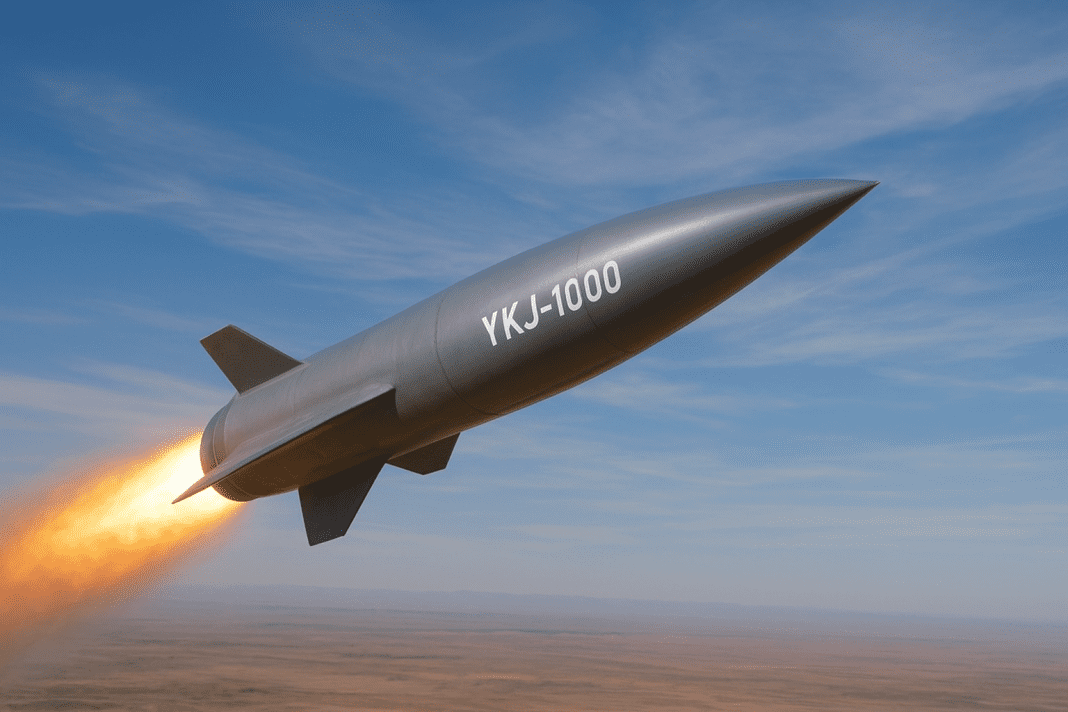A private Chinese company has announced it is producing hypersonic missiles capable of reaching Japan, marking a rare move for a non-state-owned firm in China. Lingkong Tianxing, also known as Space Transportation, revealed its missile, the YKJ-1000, in a social media video showing a test launch in a desert. The YKJ-1000, whose name roughly translates to “Flying Halberd,” is said to fly at speeds ranging from Mach 5 to Mach 7, which is five to seven times the speed of sound.
Chinese Private Company Unveils Powerful YKJ-1000 Hypersonic Missile
The YKJ-1000 reportedly has a range of 310 to 807 miles, which could place Japan’s northeastern coast within reach from China. Space Transportation also claims the missile can detect threats on its own and adjust its path to evade them. An animation in the video shows the YKJ-1000 identifying a carrier strike group and maneuvering to avoid hitting warships.
Footage in the video depicted the YKJ-1000 being deployed from a shipping container before launch, although a full demonstration of the container mechanism was not shown. The company also included animated clips of multiple YKJ-1000 missiles flying toward targets in Japan. Business Insider could not independently confirm the authenticity of the missile footage.
Hostile patrols at Senkaku — China storms island waters moments after Japan’s Taiwan stand
Affordable YKJ-1000 Hypersonic Weapons for the First Time
Traditionally, state-owned Chinese defense companies have developed hypersonic missiles for military use. Hypersonic missiles travel at least five times the speed of sound, making them extremely fast and difficult for air defenses to intercept.
Space Transportation claims it is mass-producing the YKJ-1000 at a fraction of the cost of conventional missiles, with reports suggesting the company sells it for only about 10% of what typical hypersonic missiles cost. For comparison, in 2024, the U.S. Defense Department estimated that each long-range hypersonic missile in initial batches could cost around $40 million.
China slaps new ban on Japanese seafood — diplomatic clash over Taiwan sparks trade showdown
Founded in 2018, Space Transportation has primarily focused on commercial hypersonic flight and reusable rockets before announcing this military-capable missile. The company said it has already begun producing a basic version of the YKJ-1000 and plans to release a more advanced version equipped with artificial intelligence.
The announcement could shake up China’s missile market, as hypersonic weapons have largely remained under the control of government-run defense conglomerates. The development of a lower-cost, commercially-produced missile like the YKJ-1000 could make advanced weaponry more widely available within China, although details about production scale and deployment remain limited.
Rising Tensions Between China and Japan
The missile announcement comes at a sensitive time in China-Japan relations. Japan’s new prime minister, Sanae Takaichi, has suggested her country could respond with force if China invades Taiwan. In response, China has issued advisories warning its citizens against traveling to Japan, and some Chinese airlines have canceled flights to the country. Japan, in turn, has advised its citizens to exercise caution while in China.
The animation in Space Transportation’s video showing the YKJ-1000 targeting Japan highlights the missile’s potential range. The missiles are capable of flying up to 807 miles and cruising for up to six minutes at extreme speeds. This capability aligns with concerns in the West regarding China’s hypersonic weapons, which include “carrier-killer” missiles designed to challenge naval defenses.
Hypersonic missiles are particularly notable for their speed and maneuverability, which make them difficult for traditional air defense systems to intercept. While countries like Ukraine have claimed to shoot down Russian hypersonic missiles like the Kinzhal and Zircon, the technology remains highly advanced and continues to attract global attention.
Space Transportation’s announcement is part of a growing trend of China’s hypersonic development, which also involves scramjet engines and boost-glide vehicles that allow missiles to fly unpredictably at extremely high speeds. These developments underline why hypersonic weapons like the YKJ-1000 are increasingly considered a strategic asset in modern military technology.
